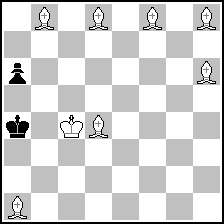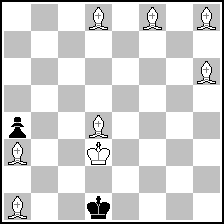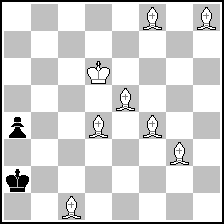
Website founded by
Milan Velimirović
in 2006
5:15 UTC


| |
MatPlus.Net  Forum Forum  General General  Troitzkys 5 Bishops Troitzkys 5 Bishops |
| |
|
|
|
|
You can only view this page!
| | | (1) Posted by Hauke Reddmann [Thursday, Sep 4, 2014 11:33] | Troitzkys 5 Bishops
You surely know his position where five black-field bishops
win against K+P on file a. Has this stuff been extended? My guess
(Geir Sune, to the rescue!) is that with a black K imprisoned
below a8-h1 and a bPa6 you can mate with seven bishops:
jettison two to force the P to a4 and then a2 (and abuse him as a
block for the bK at the same time). But I didn't work out the
details for a surefire algorithm. (It doesn't seem unreasonable
to assume this material would be accessible to Nalimoving, since
the bishops can access only half of the fields and you can add
a draw-when-on-a8/h1 condition manually.)
Hauke
| | | (2) Posted by Geir Sune Tallaksen Østmoe [Thursday, Sep 4, 2014 19:54] |
I am flattered that you mentioned my name. While I have never worked with more than 3 same-coloured bishops before, I could of course not resist the temptation to try this out. :)
With the pawn on a6, it seems to me that the position is drawn unless bK is on a2 or b1. Consider the position with bK, and add as many black-squared wB as you want:
 (= 8+2 ) (= 8+2 )
In order to chase bK away from a4 without chasing it towards a8, White must first force a5 and then play Kb5:
1.Bbd6 a5 2.Kc5 Kb3 3.Kb5 a4.
Now Black threatens to push the pawn to a2, after which bK cannot be chased away from the a4-d1 diagonal towards a1. So:
4.Ba3 Kc2 5.Kc4 Kd1 6.Kd3
 (= 8+2 ) (= 8+2 )
White had to reach this position without covering e1, otherwise Black would be stalemated. But now:
6...Ke1 7.Ke3 Kf1 8.Kf3 Ke1
and White cannot chase bK away from the a6-f1 diagonal. On 9.Kg2 Ke2, bK goes back to a6.
So unless I missed something, bK must be on a2/b1 in Troitzky's position. Your question has inspired me to do something else, though - it seems possible to let Black's pawn capture a bishop or two on its way to a2. Maybe you could have 6 or 7 bishops in such a position. To be continued!
| | | (3) Posted by Geir Sune Tallaksen Østmoe [Sunday, Sep 7, 2014 12:36] |
It seems difficult to make general rules in this kind of position, as everything depends on concrete variations and whether White has enough time to arrange his bishops without letting bK escape. However, I discovered some interesting concrete possibilities with bP on a4, where it obstructs its own king. If I am not mistaken, the following position is winning, and all seven bishops are necessary:
 (= 8+2 ) (= 8+2 )
1.Ba3! Kxa3 2.Kd5+ Kb3 3.Ba3 Kc2 4.Ke4 Kd1 5.Kf3(Ke3) Kc2 6.Ke2 Kb3 7.Kd3 Kxa3 8.Kc4 Ka2 9.Ba1 Kb1 10.Kd3 Ka2 11.Kc2 Ka3 12.Be1 Ka2 13.Bb4 a3 14.Kc3 Kxa1 15.Kb3+ Kb1 16.Ba1 a2 17.Kc3 Kxa1 18.Kc2#
| | | (4) Posted by Hauke Reddmann [Sunday, Sep 7, 2014 20:30] |
"Gustav" should be able check this in a nanosecond.
Any reader of the thread?
| | | (5) Posted by Sven Hendrik Lossin [Monday, Sep 8, 2014 13:25] |
Maybe Gustav can help but there are a lot of variations so that I think it is more about hours and days but nanoseconds.
| |
No more posts |
MatPlus.Net  Forum Forum  General General  Troitzkys 5 Bishops Troitzkys 5 Bishops |
|
|
|
 ISC 2025
ISC 2025 Forum
Forum  General
General  Troitzkys 5 Bishops
Troitzkys 5 Bishops 


